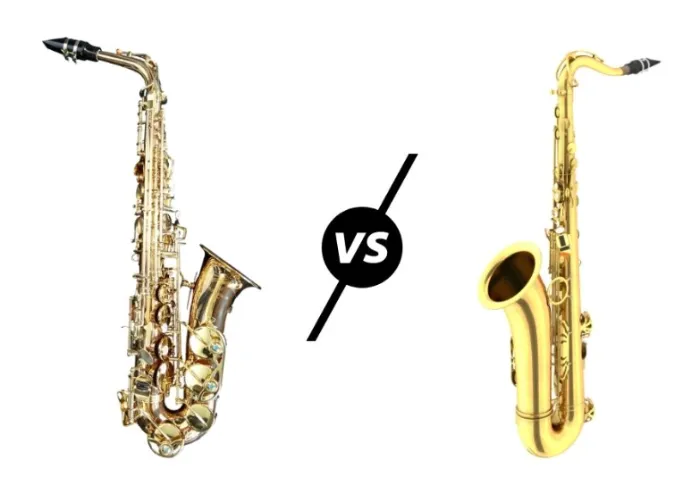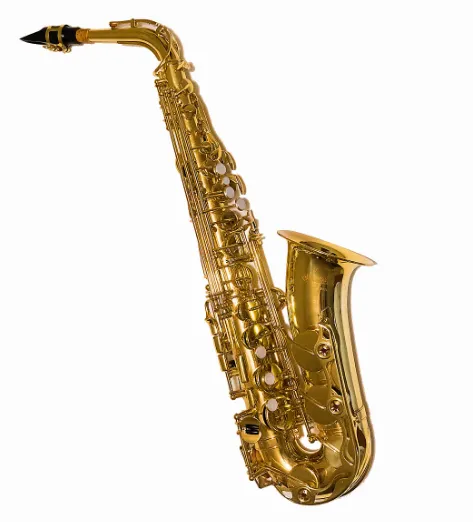Alto Vs Tenor Saxophone: What's The Difference?

The two saxophones in the saxophone family I will compare is the alto vs tenor. These two types of saxophones are a staple of Rock n' Roll, jazz music, and popular music.
However, in the saxophone family, there's also soprano saxophones, baritone saxophones and the bass saxophone.
Whether you’re a music teacher, saxophone player, or a student looking to start learning on a new saxophone to add to your bag of tricks, learning popular saxophones can be highly valuable, so it pays to understand the difference between alto sax vs tenor sax from the very start.
We'll discuss the differences between them in terms of pros and cons of each popular jazz instrument, versatility in playing famous solos, famous saxophone players on each instrument, tips for choosing the right saxophone for you, sound quality, range of notes played by each instrument, physical size comparison, and lastly price point comparison.
Let’s break down some of the key differences using pros and cons between these two instruments so that you can determine which one is the best saxophone for you.
Pros & Cons of Each Saxophone
The Alto and Tenor Saxes have advantages and disadvantages based on a multitude of factors—as well as personal preferences—so let’s take a look at the alto sax and tenor sax side by side.
E Flat Alto Saxophone Pros
Lead instrument; most solo opportunities in Jazz Band
Smaller size make it better suited for early beginners
Lighter in weight; easy transportation
Less expensive
Higher pitch range
Brighter distinct tone makes it easier for cutting through large ensembles
See Amazons top pick for Alto Saxophones available
Save over $60 on the overall pick and buy "Like New"
B flat Tenor Saxophone Pros
Lower pitch which some people prefer
Bigger body produces warm low-end resonance
Larger range of notes allow for expressive playing
Useful in ensemble settings if there are too many lead instruments
Bigger sound
See the Jean Paul starter student Tenor Sax horn
Save over $80 on Amazon's best overall pick for Tenor Sax by buying "like new"
Alto Saxophone Cons
Smaller range so fewer low notes available
Greater competition due to popularity
Smaller range limits certain melodies/solos from being played on this saxophone
Smaller key layout; awkward for larger hands
Tenor Saxophone Cons
More expensive
Heavier & bulkier size make it more challenging for younger players or those with limited strength in arms/shoulders
Larger size makes the keys slightly harder to reach for early beginners
More expensive price point when compared with alto saxophones
Famous Solos on Alto
Baker Street - Gerry Rafferty [Baker Street: EXACT Alto Sax Sheet Music Transcription]
Midnight City - M83 [Midnight City: EXACT Alto Sax Sheet Music Transcription]
Young Americans - David Bowie [Young Americans: Alto Sax Solo Sheet Music]
You Belong To The City - Glenn Frey [You Belong To The City: Alto Sax Sheet Music]
Caribbean Queen - Billy Ocean [Caribbean Queen: Alto Sax Sheet Music]
Never Tear Us Apart - INXS [Never Tear Us Apart: Alto Sax Sheet Music Transcription]
Confirmation - Charlie Parker [YouTube Video]
Find more Top Alto Saxophone Sheet Music Here ==> Top 31 Best Selling Sheet Music for Alto Saxophone
Famous Solos on Tenor
Smooth Operator - Sade [Smooth Operator Tenor Sax Solo Sheet Music]
Money - Pink Floyd [Money Tenor Sax Solo Sheet Music]
Careless Whisper - George Michael [Careless Whisper Tenor Sax Solo Sheet Music]
Just The Way You Are - Billy Joel [Just The Way You Are Tenor Sax Solo Sheet Music]
Just The Two Of Us - Bill Withers [Just The Two Of Us Tenor Sax Solo Sheet Music]
Yakety Sax - Boots Randolph [Yakety Sax Tenor Sax Solo Sheet Music]
Pink Panther - Henry Mancini [Pink Panther Tenor Sax Solo Sheet Music]
Find the sheet music transcriptions to these songs^^^ in our list of the Top 53 Best Selling Tenor Saxophone Solos Sheet Music
Famous Alto Sax Players
Charlie Parker
Cannonball Adderley
Johnny Hodges
Paul Desmond
Antonio Hart
Famous Tenor Sax Players
John Coltrane
Clarence Clemons
Eric Alexander
Jeff Coffin
Stan Getz
Comparing Alto and Tenor Saxophones
If you’re interested in learning to play the saxophone, this is a big decision to make.
Do you want to get an alto or tenor saxophone?
Both instruments produce beautiful, soulful sounds, but they are different from each other in few major ways.
Below I will compile the different famous saxophone solos performed on each saxophone to give you a better sense of which songs made each saxophone so popular.
Some of the professional musicians play alto and tenor sax, but for the most part mainly played on the saxophone listed.
Tips for Choosing the Right Saxophone For You
Now that you know which saxophone the members of professional bands use, it's time to choose which one is right for you! Here are some tips that will help make this decision easier.
Decide what type of music you want to play; do you want to play a lead instrument (Alto sax) or lay back? (Tenor sax)
Alto Sax and Tenor Sax work well in Jazz music but play very different roles most of the time.
Listen before buying; listen to the famous solos listen above on each saxophone and see which one speaks to you.
Visit the local music shop to see & hear the sound each saxophone makes firsthand before deciding on a purchase.
Before making any decisions about whether to choose alto vs tenor sax, spend time to figure out what would be best for you.
It's important that you try out both types first so that you can get an idea about how comfortable they feel when playing them.
Be sure to note what kind of sound they produce when being played together with other instruments or soloing over backing tracks etc.
If you're looking for a lead instrument that is more suitable for an early beginner opt for an alto sax.
If you’re looking for a saxophone that is more versatile including playing famous Saxophone solos then opt for a Tenor sax.
Differences in Sound Quality
The first difference between alto and tenor saxophones is sound quality.
While they have similar design features, they produce a major difference in sound due to their size differences.
The alto sax is a smaller instrument that generally plays higher pitches suitable for leading a jazz band while the tenor sax has a rich sound more suitable to blend in with the whole jazz band.
This makes the alto ideal for playing melodies while the tenor works well when accompanying in an ensemble setting.
Alto saxophones have a bright, vibrant tone that cuts through the music with clarity.
The sound can be described as “zingy” or “tangy” compared to the deeper, rounder tones of the tenor saxophone.
Tenors tend to provide a more mellow sound that is easier for blending in with other instruments in a band setting.
Range of Notes/Note register played by each Saxophone
When it comes to range of notes played by each saxophone, there is also a significant difference between an alto and a tenor saxophone.
Another important point of comparison between alto and tenor saxophones is range, especially because they are both transposing instruments.
The E flat Alto Sax plays notes ranging from low B flat to high F sharp with the same fingerings as tenor sax. On the piano, this is a low C sharp and a high A. (Reference for concert pitch instruments like piano).
Altissimo notes for these saxophone types allow for a similar higher range.
This means that with an alto saxophone you can reach similar high notes with a tenor sax but not quite as low notes.
The Tenor Sax produces notes ranging from low B flat to high F sharp with the same fingerings as alto sax. It almost sounds like it is an octave lower than alto sax.
Again, since it is a transposing instrument, the lowest note is a concert C and the highest note is an Ab. (Same as on other concert pitch instruments).
The tenor has a lower pitch that is more suited to blend in with brass instruments the ensemble but can still be used for solos as well.
The difference in sound quality comes down to personal preference; some people prefer the higher-pitched sound of the alto sax while others like the deeper tones of the tenor sax.
Physical Size Comparison:
Alto and tenor saxophones differ not only in sound quality but also in physical size.
As you might expect from their respective ranges, the alto sax plays a higher range and the tenor sax plays a lower range.
The smaller size also makes it easier for younger players or those with smaller hands to reach all the keys on an alto without having to stretch too far or strain their arms and hands too much.
Price Point Comparison
The price points for both types of instruments vary depending on brand name and materials used in construction but generally speaking, altos tend to be less expensive than their bigger counterparts due to their smaller size and simpler design.
Entry-level models are usually cheaper than professional models as well so if you’re just starting out or don’t want to invest too much money into your instrument yet then an entry-level model might be best for you.
Consider this
Altos may be cheaper upfront, but you'll still be spending a lot of time with the instrument so don't base it all off of price. Tenors are pricier but offer more versatility.
If cost is a major factor in your decision-making process, consider starting out on an alto before investing in a large tenor sax or a higher-end alto and tenor sax model later down the line when you have more experience under your belt.
This makes an alto sax a great option for beginner players who are just starting out on their musical journey!
Conclusion
There are many differences between altos and tenors when it comes down to the brass tacks such as versatility for famous saxophone solos, range of notes played by each saxophone, physical size comparison, price point comparison, pros & cons associated with each saxophone.
Ultimately, it comes down to personal preference whether Alto or Tenor will work best for your needs and preferences.
Remember that trying out both types first if possible is recommended since this will give you an idea about how comfortable they feel when playing them as well as what kind of sound they produce when being played in a solo or over backing tracks.
Choosing between an Alto or Tenor Saxophone does not have to be a difficult decision if you know what kind of music you want to play, along with what type of sound quality you are looking for.
Remember that whichever instrument you decide on will require practice, so focus on honing your skills over time; you can always change your mind especially because they share essential accessories!
Good luck!
Related:
Learn How to Draw an Alto Sax in 2 Different Easy Ways






